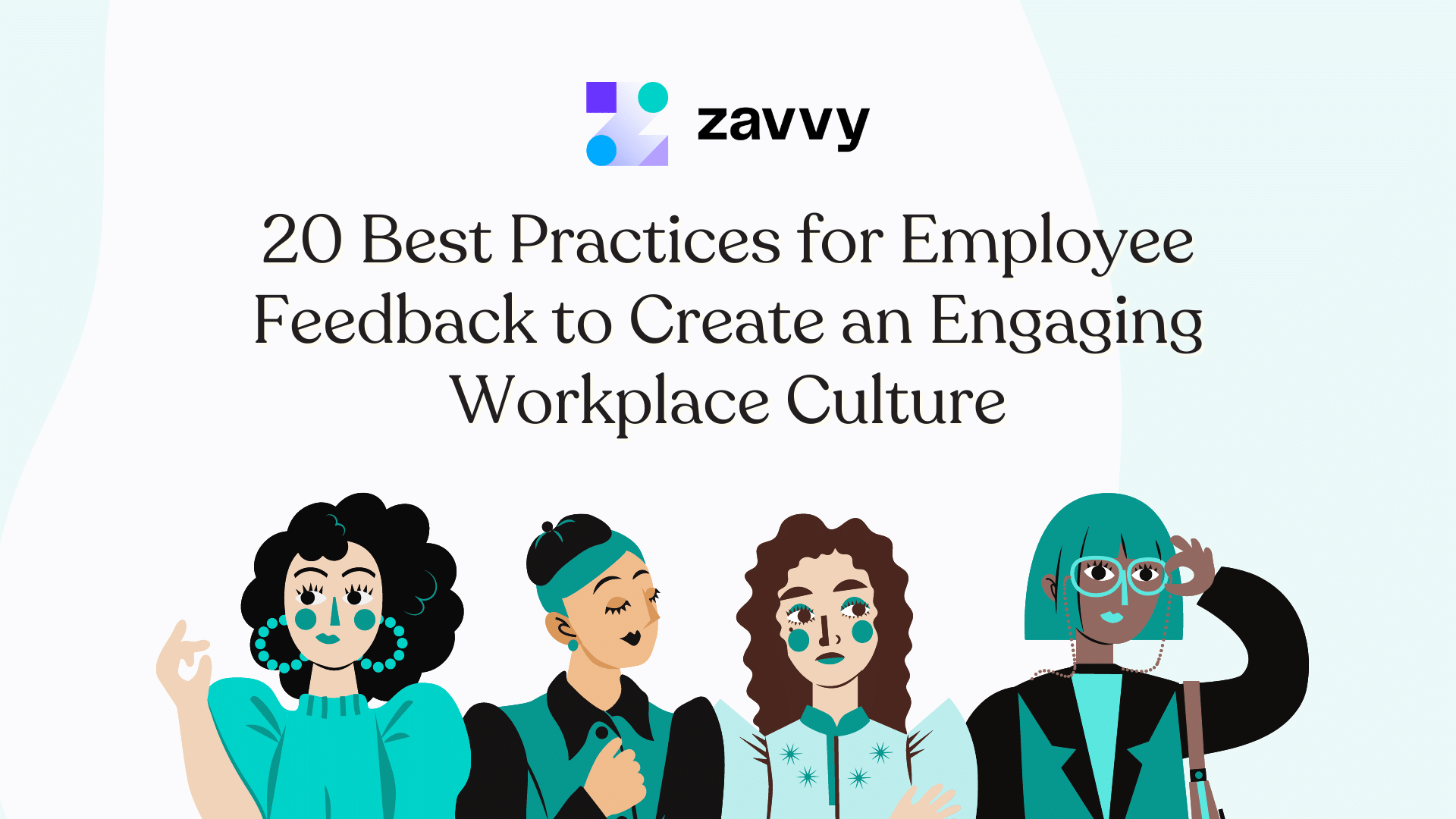
Keke Kaikhosroshvili
Keke is Zavvy's expert in learning experience. On our blog, she shares experience and insights based on her studies in learning design and experiences made with our customers.


Giving and receiving feedback is an essential part of the employee experience. But giving meaningful, constructive feedback is not always a piece of cake.
How do you ensure that your employees receive feedback well even when its contents are not 100% positive?
And how do you ensure that they can actually apply the feedback to their betterment?
Giving feedback is one of the best ways to show your employees that you value their work and contributions. However, calling them in for an annual impersonal performance review doesn't cut it.
In this article, we'll discuss how to craft meaningful employee feedback that will actually make a difference and help your employees grow in the right direction.
Discover our list of employee feedback best practices that will help you deliver feedback with finesse, especially when it's not all positive.
Together with our curators, we have created a library of actionable digital marketing resources. Personalized to your team's needs.
Today's workforce doesn't just want to work. Instead, employees want to work somewhere with purpose, where they can learn and grow.
Your people are willing to take a pay cut to have a job enabling them.
"Across age and salary groups, workers want meaningful work badly enough that they're willing to pay for it." - Harvard Business Review.
The core principle of employee feedback is treating employees like human beings. Not faceless cogs in a money-making machine, but people with their hopes, ambitions, and dreams.
"Employees who believe management is concerned about them as a whole person – not just an employee – are more productive, more satisfied, more fulfilled. Satisfied employees mean satisfied customers, which leads to profitability." - Anne M. Mulcahy - former CEO of Xerox.
That's why giant companies like Google, Cisco, Microsoft, and Salesforce invest so heavily in employee engagement. They understand that their profits and growth – aka their survival – depend on it.
Developing an engaged workforce also means creating a strong feedback culture in your company.
Employees need to feel like they can give – and receive – feedback without repercussions. They need to know that HR and their bosses care and listen to their voices.
The benefits of having a feedback culture in your company are well-documented. Companies with strong feedback cultures see:

It's a simple formula: engaged employees = better business outcomes.
Employee feedback holds one of the keys to unlocking that potential.
Giving employee feedback is an art, not a science. Still, there are some tried-and-true best practices that HR teams can follow to make sure your feedback is always on point.

First, take a step back and think about what you're trying to accomplish with your feedback.
Do you want to give positive reinforcement? Maybe you need to address a specific issue? Or simply help an employee grow in a certain area?
Tip: Be as specific as you can.
Avoid general comments like, "You're doing a great job!" or "We need to talk about your attitude."
Instead, try something like:
"I noticed how you handled that customer complaint about the late shipment. Great work!" or
"I'm concerned about your recent string of absences last month. Can we talk about what's going on?"
You can't control how employees will receive your feedback, but you can control how you deliver it.
Tip: You can never go wrong by framing your feedback constructively, especially when you want to address a problem.
Here's how to turn "negative" feedback into constructive feedback:
Tip #1: Notice how constructive feedback transforms the problem into an opportunity for growth.
Tip #2: Giving constructive feedback also shows that you're more interested in helping the employee succeed rather than just placing blame.
When you're giving feedback in the workplace, avoid using absolute terms like "always," "never," and "every time."
First, it's rarely true and often just an exaggeration. Second, it's hurtful.

Tip #1: No one wants to feel like they're incapable of improvement.
Tip #2: Circle back to the specific goal you set for the feedback. Talk about the particular behavior you want to address, and use concrete examples instead of generalizations.
For example, do you want to discuss their tardiness with them? Cite how many days they've been late in the past month instead of telling them, "You're always late."
Tip #3: Open up a productive conversation instead of shutting it down.
A "compliment sandwich" is when you slip a negative comment in between positive feedback, thinking it will make the pill easier to swallow.
It usually goes something like this:
"You're doing great overall, but you must work on your time management skills. I've noticed you've been coming in late a lot lately. Great work on that big project last week, by the way!"
The problem with this approach is that employees see right through it. They know you're just trying to sugarcoat the bad news. It also makes the "compliment" sound fake.
Tip #1: Just get to the point instead of wasting your breath (not to mention their time).
Tip #2: Be direct, honest, and respectful when giving feedback. And as long as you're trying to give constructive feedback, you're on the right track.
Your feedback should consider your working relationship with the employee. For instance, are they your peer, direct report, or supervisor?
If you're giving feedback to your supervisor or manager, you'll want to be more formal and professional.
On the other hand, if you're giving feedback to a peer, you can afford to be a little more casual.
And if you're giving feedback to a direct report, you'll want to strike a balance between the two.
Tip: Tailoring the tone of your feedback to the working relationship will help ensure that it's well-received.
Giving effective feedback in the workplace is only half the battle.
The other half is ensuring that employees are actually listening to what you're saying. And not just nodding along.
Tip: To ensure that feedback is received, you must practice active listening. Transform the feedback session from a one-way lecture into a two-way dialogue.
Here are some extra tips for active listening:

Active listening shows employees that you respect their opinion and want to hear what they say.
If your HR policies only require you to give feedback during an annual review, you're doing it wrong.
One feedback session per year means you have little to no idea how your employees are doing daily.
Tip #1: Give feedback continuously, not just once a year. That way, employees can course correct as they go, and you can avoid any surprises come review time.
Tip #2: Use 360 feedback to get a complete and more nuanced picture.
You decide what "regular feedback" looks like for you, but here are some tips you can incorporate into your process:
There's no point in critiquing an employee for something out of their control.
For example, you wouldn't critique them for a client not paying their invoice on time. The only thing an employee can do to improve in this situation is to follow up with the client and escalate the issue if necessary.
Instead, focus your feedback on things the employee can change and improve.
Here are some examples:
These are all things an employee can work on, regardless of the situation.
Feedback bias happens when personal experiences and attitudes towards the employee you're reviewing are shaping the feedback instead of objective and measurable facts.
Preconceptions over someone’s age, gender or origin could take over concrete facts when shaping your feedback.
➡️ Address feedback bias by understanding its root causes and start taking action with our 5 tips for overcoming unconscious bias in the workplace.
So you've given your employees feedback. Now what?
It's not enough to just tell an employee what they need to work on — you also need to provide them with a clear action plan.
Creating an action plan might mean:
This way, they know their growth is important and will hold them accountable for meeting the goals you've set together.
Treat employee feedback as an evolving process, not a one-time event.
Tip: After you give feedback, follow up at a later date to see how the employee is progressing. Show that you're committed to helping them improve.
Here's how you can follow up effectively:

🔹 Set a specific date and time for the follow-up meeting.
🔹 Come prepared with examples of the employee's progress (or lack thereof).
🔹 Be open to hearing the employee's perspective.
🔹 Avoid coming across as aggressive.
If you follow up properly, you can use feedback sessions as an opportunity to build trust and strengthen your relationships with employees.
In addition to scheduled feedback sessions, make an effort also to give employees real-time feedback.
For example, if you see an employee doing something well, let them know immediately. It will show them that you're paying attention and appreciate their hard work.
Tip: Acknowledging employee progress will also encourage them to keep up the good work in the future.
Need to give negative employee feedback? Avoid doing it in public. You don't want to embarrass the employee and make them defensive.
Tip #1: Ask people if they're free to talk privately. Then schedule a meeting or send them a direct message. This way, they can hear what you have to say without feeling like being on the spot.
On the other hand, praise in public. Getting positive feedback in front of the team or customers can work wonders in boosting morale and motivation.
Tip #2: Ensure the employee is comfortable with being in the spotlight. Even if the feedback is positive, if it catches the employee off guard, the discomfort might overshadow the acknowledgement they are receiving. Again, knowing your employee goes a long way when giving feedback.
Documentation is critical for all HR interactions, and this includes employee feedback.
Tip #1: Record it in the employee's file when you give feedback. Having a written record of the conversation can be helpful if there are any issues.
In addition to documenting the feedback session, track employee progress as well. For example, are they meeting the goals you set? Did anything change after you gave them feedback?
Tip #2: Recording this information will help you evaluate your feedback strategy's effectiveness and make necessary adjustments.
Tip #3: Attaching the feedback to the employee's growth plan will be even more meaningful. Feedback is correlated with their growth aspirations and can provide concrete steps for getting to the next level of their skills or on the career ladder.
➡️ Struggling to find the right words to say? Here are 35+ positive employee feedback praises to inspire you! On the other hand, use these 45 negative employee feedback examples to deliver criticism with tact.
Your employees are your richest source of information.
Want to know what's really going on in your workplace? Here's how to get honest feedback from employees.

Some employees are simply too shy to speak up, no matter how much you reassure them. Others are afraid of retaliation.
Protecting their anonymity can encourage employees to be more forthcoming with their opinions, suggestions, and complaints.
There are a few ways to do this:
The best methods won't require them to put their name to their feedback or log in to their email or company intranet.
Don't make employees jump through hoops just to share their thoughts with you.
Tip: The easier it is to give negative and positive feedback, the more likely they'll do it.
Remove barriers like lengthy forms or complicated login processes. And make sure you've got a good mix of channels for employees to choose from, including:
An employee pulse survey is a short survey that measures employee satisfaction on an ongoing basis.
Pulse surveys can help you stay on top of employee sentiment and identify issues early. It works for any workplace topic, too, such as:
You can even send out a pulse survey about the feedback process to get employees' thoughts on how it's going.
A "skip-level" conversation is a meeting between an employee and their boss's boss. It's called "skip-level" because it allows employees to bypass the chain of command and speak directly to a senior leader.
This can be an invaluable experience for both parties.
For one, it gives the employee a chance to speak their mind without fear of reprisal.
It also allows leaders to get unfiltered negative and positive feedback about the company.
Skip-level conversations can be conducted one-on-one or in small groups.
Tip: If you go the group route, keep the conversation focused and avoid getting sidetracked by unrelated topics.
No one understands the employee experience better than employees themselves.
So why not tap into that knowledge?
Put the power in their hands by letting them brainstorm and write their own surveys to be approved by HR. Trust them to come up with questions that will get at the heart of the issues they're facing.
Aside from being more engaged, employees will also feel a sense of ownership over the feedback process- which can only encourage them to participate more.
Tip: Ensure that the employees want to participate. Forcing them might be counterproductive.
The fastest way to never get feedback again is to ignore the feedback you do get.
If employees see their suggestions falling on deaf ears, they'll quickly lose faith in the process.
Show that you're taking employee feedback seriously by acting on it, for example, by:
In the case of anonymous feedback, you can't always take action directly with the employee. But you can still show them their input is valued by sharing it with other departments or using it to inform company-wide changes.
Employee feedback is precious not just for performance reviews but for positive and people-centered workplace culture.
Our 360 feedback software can help you easily collect, analyze, and act on employee feedback.
Start reaping the benefits of employee feedback right now.
To see how Zavvy can help you drive feedback culture at your organization, schedule a free 30-minute demo today.

Upskill your team every week with the best contents and personalized recommendations.

Giving and receiving feedback is an essential part of the employee experience. But giving meaningful, constructive feedback is not always a piece of cake.
How do you ensure that your employees receive feedback well even when its contents are not 100% positive?
And how do you ensure that they can actually apply the feedback to their betterment?
Giving feedback is one of the best ways to show your employees that you value their work and contributions. However, calling them in for an annual impersonal performance review doesn't cut it.
In this article, we'll discuss how to craft meaningful employee feedback that will actually make a difference and help your employees grow in the right direction.
Discover our list of employee feedback best practices that will help you deliver feedback with finesse, especially when it's not all positive.
Get a demo!
We'll be happy to show you around and answer all your questions.
Trusted by innovative companies



We'll be happy to show you around, answer your questions, or arrange a free trial.
Erhalten Sie eine kostenlose Demo unserer Onboarding-Software.
Vertraut von



Your Training & Development Strategy - Solved in 1 Tool.
Trusted by innovative companies



We'll be happy to show you around, answer your questions, or arrange a free trial.
Learn how Zavvy helps you drive performance, development, and engagement.
Trusted by innovative companies



We'll be happy to show you around, answer your questions, or arrange a free trial.
We'll be happy to show you around and answer all your questions.
Trusted by innovative companies



We'll be happy to show you around, answer your questions, or arrange a free trial.
Gerne zeigen wir Ihnen ganz unverbindlich unsere Plattform im Detail.
Vertraut von modernen Unternehmen



Get a demo!
We'll be happy to show you around and answer all your questions.
Trusted by innovative companies



We'll be happy to show you around, answer your questions, or arrange a free trial.
Erhalten Sie eine kostenlose Demo unserer Software für Mitarbeiterenwicklung und Training.
Moderne Unternehmen
setzen auf Zavvy


